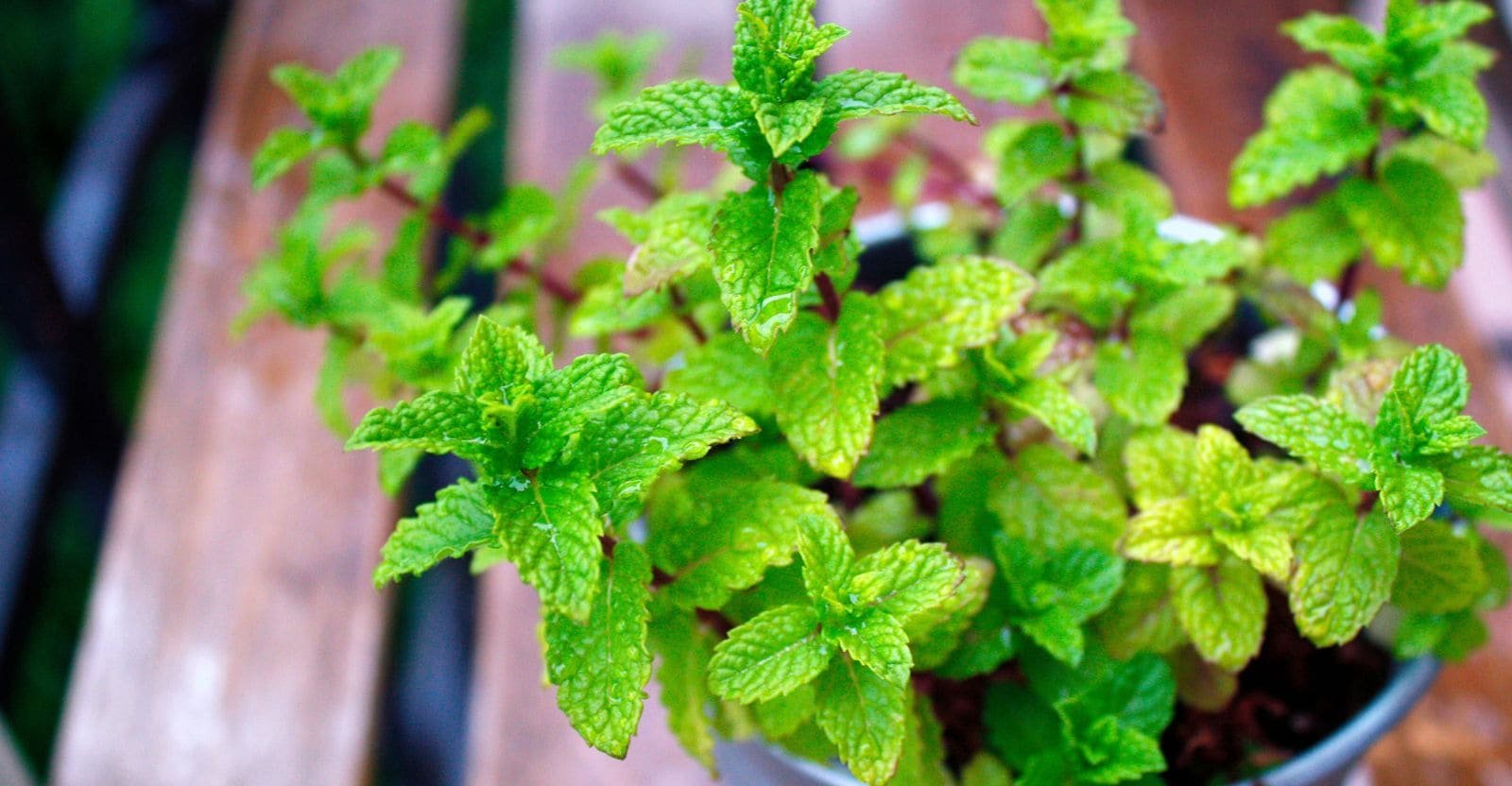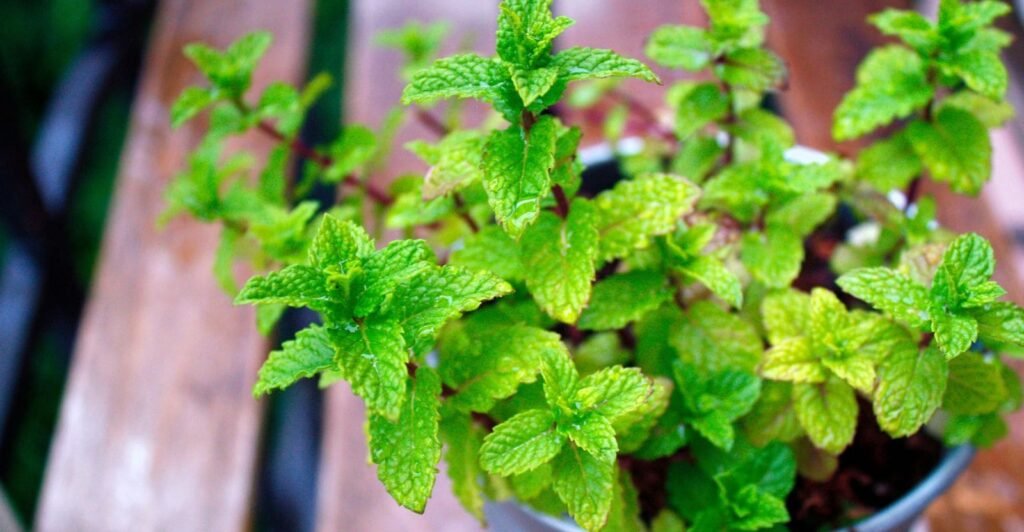
How to Grow Mint Indoors
If you’re a fan of mint, you’re in luck—it’s one of the easiest herbs to grow both indoors and outdoors, and it thrives in containers. Whether you’re looking to add fresh mint to your iced tea, refreshing juices, or even mint chocolate chip ice cream, growing mint indoors lets you enjoy it all year long. Plus, mint’s fragrant leaves add a wonderful aroma to any room.
This guide will walk you through everything you need to know about growing and caring for mint indoors, from propagation to harvesting.
Why Grow Mint Indoors?
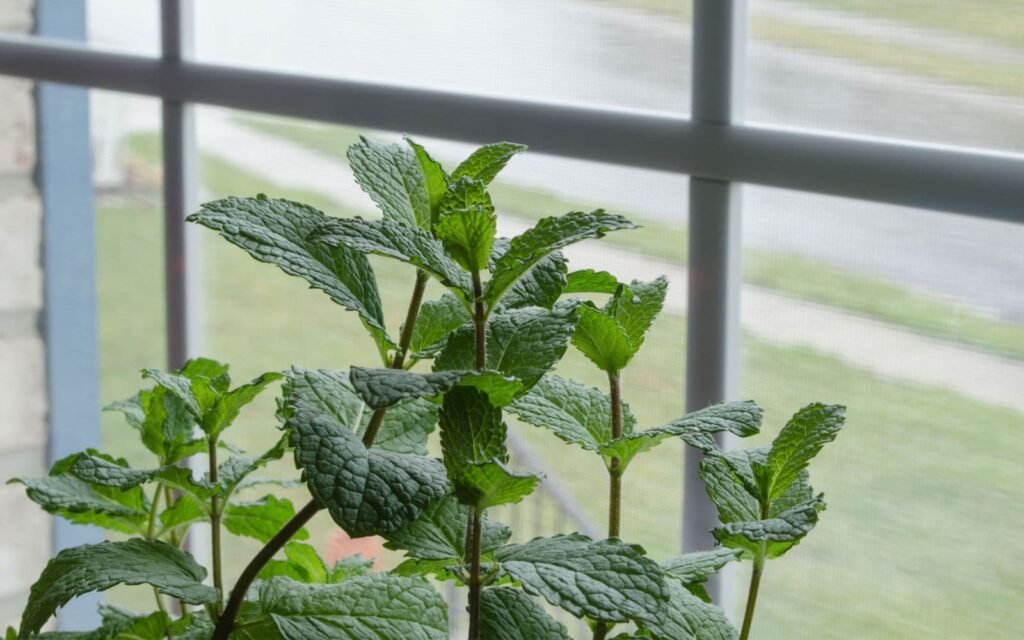
Growing mint indoors is a fantastic way to have fresh, aromatic mint all year round. Whether you use it in drinks, desserts, or savory dishes, having your own supply of mint can save you a trip to the store and give you access to fresh leaves anytime.
Mint is versatile and can be used in everything from teas and beverages to desserts and even medicinal preparations. It comes in a variety of flavors, and the most popular types for indoor growing include:
- Peppermint: Known for its sweet and delicate flavor, perfect for teas, desserts, and even medicinal uses.
- Spearmint: Offers a sharper, more intense flavor and is great for confections, toothpaste, soaps, and shampoos.
- Chocolate Mint: A fun variety with a chocolatey scent, perfect for desserts.
- Apple Mint: With a mild, fruity flavor, it’s excellent in salads and fruit-based dishes.
- Orange Mint: Has a robust citrus flavor, ideal for adding a twist to sweet dishes.
Mint is also great for small spaces like balconies or windowsills, where it can get plenty of light.
Mint Varieties to Try

There are over 25 different varieties of mint, but here are a few of the most popular ones that you might want to grow indoors:
- Peppermint: Used in teas, desserts, and even to relieve headaches or nausea.
- Spearmint: A bit sweeter than peppermint, perfect for confections and making mojitos.
- Apple Mint: A great option for fresh fruit salads or exotic desserts.
- Orange Mint: Strong citrus flavor, perfect for flavoring drinks and desserts.
- Licorice Mint: Has a strong, fresh aroma, great for herbal teas and salads.
Mint Plant Growing Basics

Here’s a quick look at the conditions your mint plant needs to thrive:
| Growth Factor | Condition |
|---|---|
| Soil | Moist soil with rich organic compost |
| Water | Water regularly (2–3 times a week) |
| Sunlight | 6–8 hours of sunlight |
| Temperature | 65–70°F (18–22°C) |
| Fertilizer | High nitrogen liquid fertilizer |
| Propagation | Stem cuttings, seeds |
| USDA Zone | 3–11 (depends on variety) |
How to Propagate Mint

Mint is incredibly easy to propagate. There are two common methods for growing mint indoors:
1. Propagate Mint from Seeds
Mint seeds are fairly easy to grow. Here’s how to do it:
- Get your seeds: You can buy healthy mint seeds online or at a garden center.
- Prepare the container: Choose a container that’s about 10 inches deep and 6-8 inches wide for good root space.
- Soil prep: Use slightly acidic soil with a pH of 5.5–7.5. Add compost or natural fertilizer to help the seeds grow.
- Plant the seeds: Soak your seeds in mildly warm water for a few hours before planting them in the soil. Bury the seeds about 1/4 inch deep, and make sure there’s a couple of inches between each seed to avoid overcrowding.
- Water regularly: Keep the soil moist but not soggy. Mint seeds usually germinate in 10-15 days.
- Maintain: Water the plant near the roots, and prune off any flowers to prevent the taste from turning bitter.
2. Propagate Mint in Water (Hydroponic Mint)\
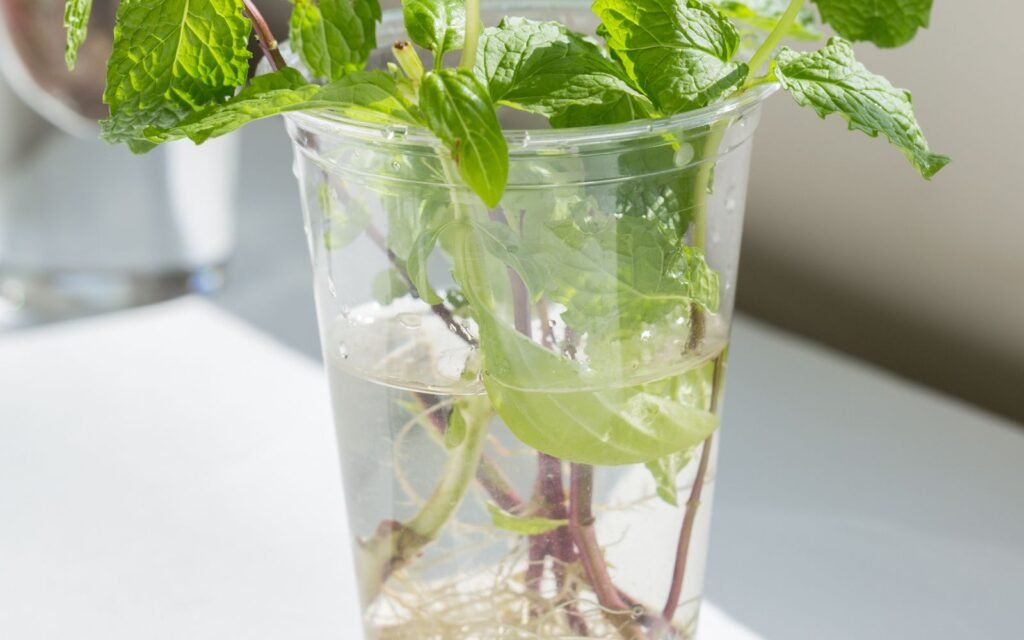
If you want to skip the soil mess, try growing mint in water:
- Get a container: Use a net container or a jar with holes at the bottom to hold the mint stem.
- Prepare the mint: Cut a healthy mint stem, remove a couple of leaves from the bottom, and make sure only the stem is submerged in water.
- Encourage root growth: Place the stem in a container filled with water. Make sure the nodes are submerged (nodes are the parts where leaves or branches grow).
- Place in sunlight: Keep the container in a spot that gets 6–8 hours of sunlight per day.
- Change water: Replace the water every 2–3 weeks to prevent stagnation. Your mint will start developing roots and new branches in 14–20 days.
Growing and Caring for Mint Indoors

Growing mint indoors is easy, but you need to provide the right conditions for it to thrive.
Soil
Mint likes moist, well-drained soil. Use a mix of perlite, organic compost, and sand to create a perfect growing medium. Ensure your container has good drainage to prevent waterlogging.
Watering
Mint needs about 1.5 inches of water per week. Check the soil moisture by feeling the top layer. Overwatering or underwatering can lead to root rot, so always water the plant near the roots.
Fertilizing
:strip_icc()/bhg-picking-mint-GettyImages-1193495243-e5488885290a44c1bfddaf70d5a16afa.jpg)
Mint benefits from a high-nitrogen fertilizer, especially if you want it to grow lots of leaves. Use liquid organic fertilizer every 3 weeks during the growing season (spring and summer). During winter, you can reduce the fertilization.
Temperature and Humidity

Mint grows best when temperatures stay between 65–70°F (18–22°C) during the day. At night, ensure it doesn’t dip below 55°F (13°C). Mint doesn’t like dry air, so it’s a good idea to use a humidifier or mist the plant lightly to keep the humidity up.
Sunlight
Mint needs at least 6–8 hours of sunlight daily to thrive. If you’re growing mint indoors, place it near a south-facing window for optimal sunlight. Rotate the plant occasionally to avoid it becoming leggy.
Pruning and Harvesting Min
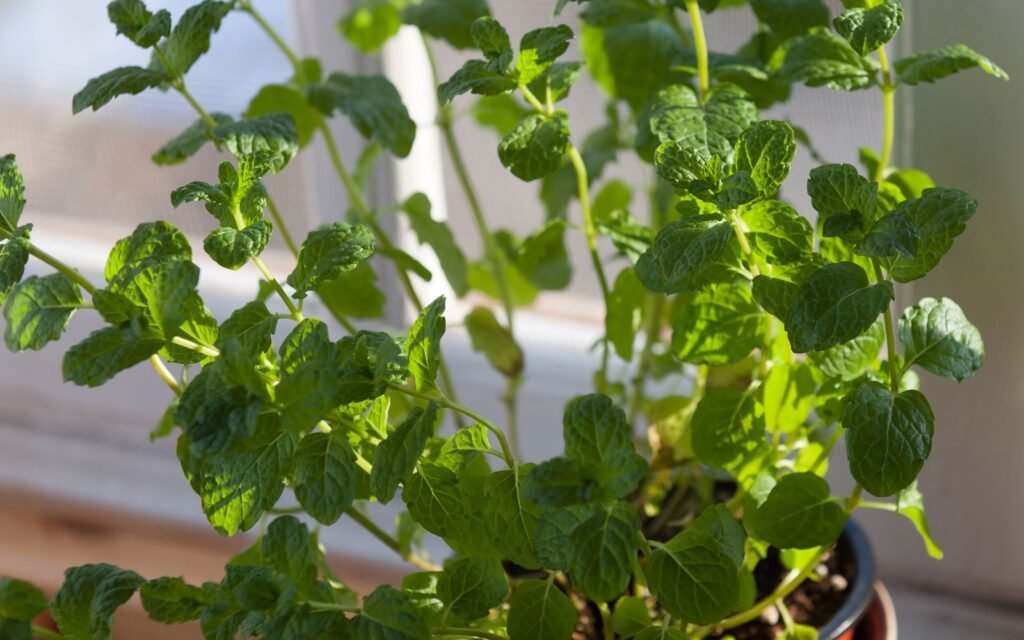
Mint is a fast-growing plant that needs regular pruning to stay healthy.
- Prune regularly: Trim any leggy or overgrown branches to keep the plant looking neat. Also, remove any flowers, as they can make the mint taste bitter.
- Harvesting: Harvest mint leaves once the plant is about 6 inches tall. Don’t take more than 1/3 of the plant at a time to keep it healthy. Harvesting regularly helps the plant grow more leaves.
Mint Pests and Diseases
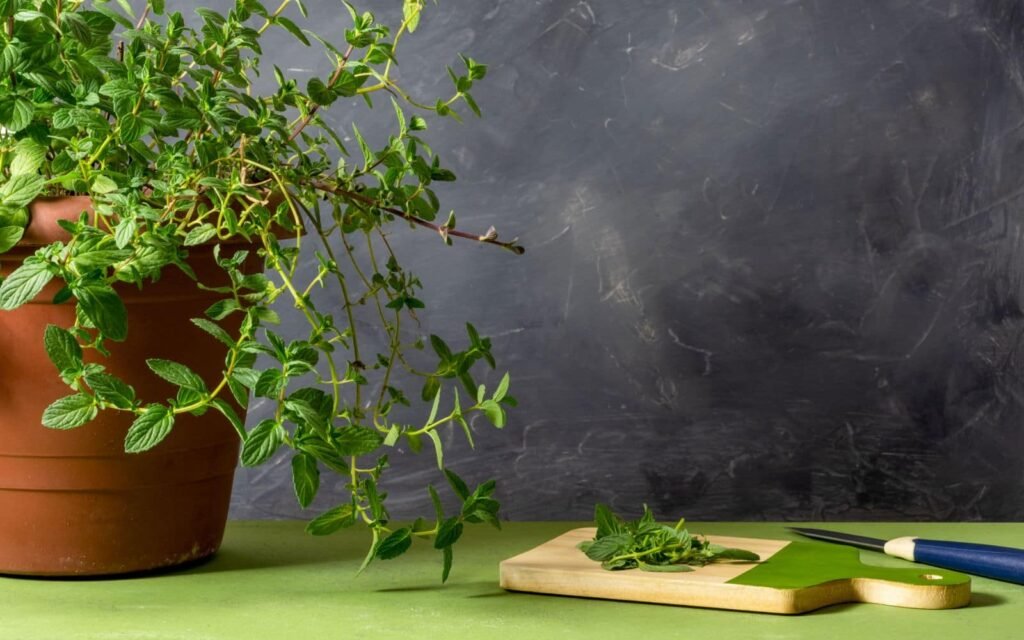
Mint is prone to certain pests and diseases, so here are some things to watch out for:
- Mint Leafhopper: These insects suck sap from mint leaves, causing damage. You can hose them off or use insecticidal soap.
- Mint Aphid: Aphids also suck sap from mint stems. Use soap sprays or wipe the plant with a damp cloth.
- Powdery Mildew: This fungus creates a white powder on the leaves. Improve air circulation and treat with antifungal solutions.
- Stem Canker: This fungal disease attacks the stems, causing wilting and stunted growth. Remove affected stems and treat with fungicides.
Common FAQs

Does mint come back every year?
Yes, mint is a perennial, so it will grow back every year if properly cared for.
What happens if your mint plant starts flowering?
Mint flowers are lovely, but they can make the leaves taste bitter. Prune any flowers off to keep the mint tasting fresh.
Why does the mint plant turn black?
Blackened mint leaves could be caused by thrips (pests), overwatering, or underwatering. Check for pests, adjust your watering schedule, and ensure proper soil conditions.
Does mint grow well in pots?
Absolutely! Mint grows well in pots, which makes it easy to move around. Just make sure the pot is large enough for the roots to spread out.
FAQs for Growing Mint Indoors
1. What are the ideal growing conditions for mint indoors?
Mint grows best in a location with bright, indirect light. A windowsill that receives at least 4-6 hours of sunlight a day is ideal. Mint prefers a temperature range of 65-70°F (18-21°C) and humidity levels that are moderate to high. Ensure the plant is not exposed to drafts or temperature extremes.
2. How often should I water mint indoors?
Mint likes consistently moist soil, but it’s important not to overwater it. Water your mint when the top inch of the soil feels dry. Make sure the pot has drainage holes to avoid waterlogging, which can lead to root rot. During the winter months, reduce watering slightly as the plant’s growth slows down.
3. Can I grow mint in any type of container?
Yes, you can grow mint in any container with proper drainage holes. A 6 to 8-inch pot is ideal for growing mint indoors. Keep in mind that mint is a fast-growing plant and can become invasive in confined spaces, so it’s a good idea to consider using a larger container or a pot with a barrier to contain the roots.
4. Does mint need a lot of space to grow?
Mint is known for being quite hardy and spreading rapidly. While it doesn’t need a vast amount of space, it does benefit from having room for its roots to grow. If you plan to grow mint indoors for an extended period, you may want to repot it into a larger container once the plant begins to outgrow its current pot.
5. How do I prune mint to keep it healthy?
Pruning mint is essential for maintaining a compact, healthy plant. Regularly pinch back the tips of the stems, cutting just above the leaf node, to encourage bushier growth. Remove any flower buds as well, as flowering can reduce the plant’s flavor and cause it to become leggy. Pruning also helps prevent the plant from becoming too tall and sparse.
6. How often should I fertilize mint indoors?
Mint doesn’t require a lot of fertilizer, but feeding it once a month during the growing season (spring and summer) with a balanced liquid fertilizer can promote healthy growth. You can reduce fertilizing during the fall and winter when the plant is not actively growing.
7. Can I grow mint in water?
Yes! Mint can be propagated in water. Place a few healthy stems in a jar of water, making sure the cut ends are submerged. Change the water every few days to keep it fresh, and once roots form, you can transplant the mint into soil. This method is also great for growing mint temporarily indoors if you want a small amount to use in recipes.
8. How do I prevent pests on my indoor mint plant?
Mint is generally pest-resistant, but occasionally aphids, spider mites, or whiteflies may appear. If you notice pests, you can gently wipe the leaves with a damp cloth, or use insecticidal soap or neem oil to treat the plant. Regularly inspect the leaves, especially the undersides, where pests tend to hide.
9. Can I grow mint indoors year-round?
Yes, mint can be grown indoors year-round as long as it receives adequate light, water, and nutrients. Be sure to place it in a bright spot and keep it away from drafts, and you’ll be able to enjoy fresh mint all year long.
10. How can I harvest mint without damaging the plant?
To harvest mint, simply snip off the leaves and stems using clean scissors or pruning shears. Always leave enough of the plant intact to continue growing. The best time to harvest mint is just before it flowers when the leaves have the most flavor. By regularly harvesting, you’ll encourage more growth and keep the plant healthy.
11. Can I grow mint with other plants indoors?
Yes, mint can be grown with other plants, but it’s important to be mindful of its growth habits. Mint can spread quickly, so it may crowd out smaller plants. Consider placing mint in its own container to avoid it taking over the rest of your indoor garden. If you want to grow it with other herbs, make sure the other plants have similar light and water requirements.
12. Why is my mint turning yellow or wilting?
Yellowing or wilting mint can be caused by several factors, including overwatering, poor drainage, insufficient light, or pests. Make sure the plant is receiving enough light and is not sitting in soggy soil. If the soil is too compact, consider repotting with fresh, well-draining soil. Also, check for pests, which can cause stress and damage to the plant.
Conclusion
Growing mint indoors is a great way to enjoy fresh, flavorful herbs year-round. By providing the right light, watering, and care, you’ll have a thriving mint plant that adds flavor to your meals and fills your home with its delightful scent. Regular pruning, proper watering, and occasional harvesting will keep your mint healthy and productive. Happy gardening and enjoy the benefits of homegrown mint!

